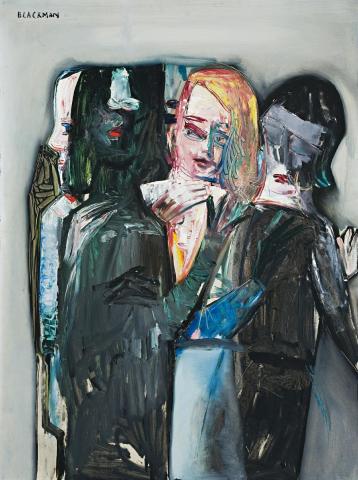THE GIRLS, 1961
Charles Blackman
oil on composition board
121.0 x 90.5 cm
signed and dated upper left: BLACKMAN 61
Rudy Komon Gallery, Sydney
Private collection, Sydney
The year 1961, when The Girls was painted, was remarkable for Charles Blackman. Arriving in London in February on a Helena Rubenstein travelling scholarship, he was represented in the historic Recent Australian Painting exhibition at the Whitechapel Gallery, chosen with Brett Whiteley and Lawrence Daws to represent Australia in the Biennale des Jeunes at the Musée d'Art Moderne, Paris, and in November held a solo show at London's Matthiesen Gallery. At the height of his creative powers and stimulated by the European scene, Blackman produced some outstanding works, which readily gained critical acclaim. Bryan Robertson, an early London champion of contemporary Australian art wrote of his paintings in the catalogue to the solo show:
Part of their essential character springs from the interpretation, marvellously developed and sustained, between the tenderness and grace of the personages contained in the paintings and the fiercely, implacably controlled means taken to give those personages life and eloquence within the terms of painting itself.1
This is apparent in The Girls, close to those works Blackman painted in his first London years of groups of young people standing together, preoccupied. Robertson perceptively observed, 'The fragile gestures and spontaneous movements among people in the streets around us are caught, and made eloquent.'2 Developed out of earlier Australian paintings, it has an interesting affinity with the very moving Tryst, 1959, in which the more neutral background and scraping of grey paint across the pale yellow surface sets up angles of tension. Moreover, the same two figures are echoed in The Girls. The central figure, so singled out by the spotlight of bright coloured hair, paradoxically becomes a figure of isolation against the darken silhouettes on either side. Another painting of 1961, Four Friends is even closer, the figurative grace contrasted with the strong blacks, of outlines and shades, combining yet separating within the group in ceaseless interaction and isolation. Although more concentrated in its grouping, the same applies to The Girls. Hands are allied to facial expressions as significant means of communication. Yet we are not part of their conversation. Backs are turned to the viewer, faces darkened, with gestures reserved for those of the enclosed group, block-like in its concentration of form. Cleverly, such exclusion arouses curiosity and obliges the viewer to look further for an opening. It is as Thomas Shapcott, Blackman's biographer wrote, 'The precise relationships, of warmth, possessiveness, need, or just the being one in a group, as security, are subtly and lyrically defined and made real to us.'3
1. Robertson, B., quoted in Shapcott, T., Focus on Charles Blackman, University of Queensland Press, Brisbane, 1967, p. 57
2. ibid., p. 57
3. Shapcott, T., op. cit., p. 58
DAVID THOMAS
